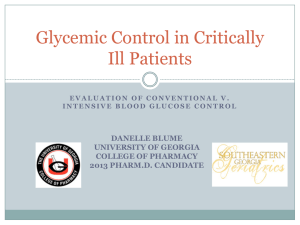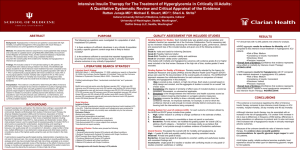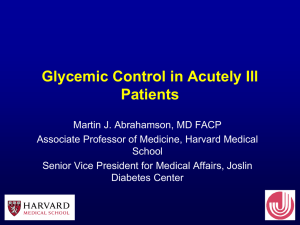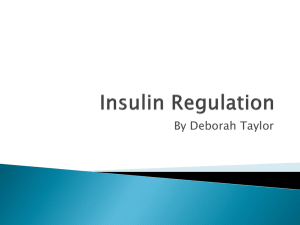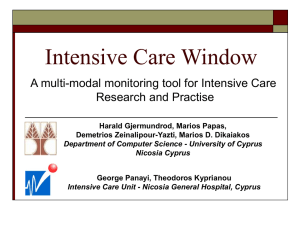Intensive Insulin Therapy in Critically Ill Patients
advertisement
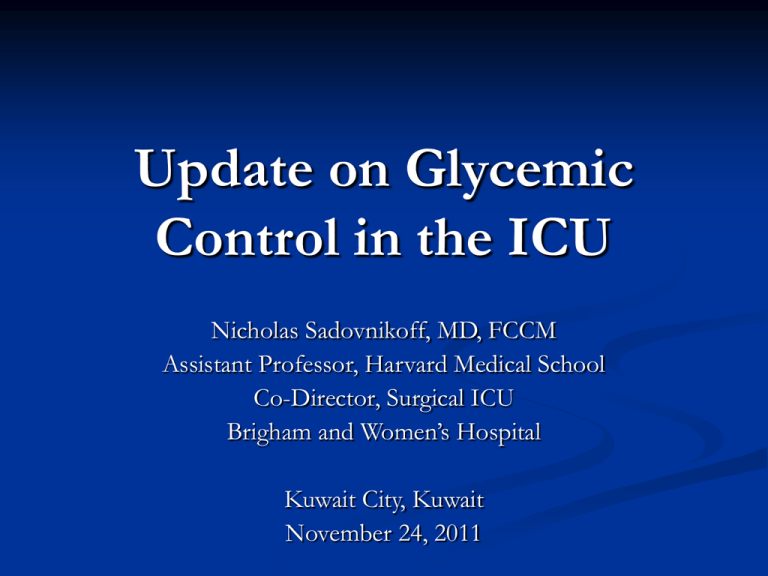
Update on Glycemic Control in the ICU Nicholas Sadovnikoff, MD, FCCM Assistant Professor, Harvard Medical School Co-Director, Surgical ICU Brigham and Women’s Hospital Kuwait City, Kuwait November 24, 2011 What is the right target? What is your target glucose level for the critically ill patients in your ICU (choose the closest to your practice)? 1.) 2.) 3.) 4.) 80 - 109 mg/dl 100 - 140 mg/dl 140 - 180 mg/dl 180 - 220 mg/dl Hyperglycemia common in critically ill patients associated with adverse outcomes Mortality Morbidity Rate of infections Length of stay (LOS) Intensive Insulin Therapy in Critically Ill Patients For decades, hyperglycemia in the critically ill population was accepted as the “price of doing business” Intensive Insulin Therapy in Critically Ill Patients For decades, hyperglycemia in the critically ill population was accepted as the “price of doing business” It was considered an adaptive response, and intervention was only undertaken if DKA or severe hyperosmolar states developed Intensive Insulin Therapy in Critically Ill Patients In the 1990s, Furnari et al published studies showing lower sternal wound infection rates in cardiac surgical patients with control of glucose (180-220 mg/dl) Intensive Insulin Therapy in Critically Ill Patients In the 1990s, Furnari et al published studies showing lower sternal wound infection rates in cardiac surgical patients with control of glucose (180-220 mg/dl) This led to the dissemination of the “Portland Protocol”, but it was not widely accepted Intensive Insulin Therapy in Critically Ill Patients In 2001, glucose management would change drastically Van den Berghe G, et al. N Engl J Med. 2001 Intensive Insulin Therapy in Critically Ill Patients In 2001, glucose management would change drastically Van Den Berghe et al, NEJM Mortality can be decreased with tight glucose control Van den Berghe G, et al. N Engl J Med. 2001 Intensive Insulin Therapy in Critically Ill Patients In 2001, glucose management would change drastically Van Den Berghe et al, NEJM Mortality can be decreased with tight glucose control As well as a number of other outcomes! Van den Berghe G, et al. N Engl J Med. 2001 Van den Berghe Study Single center Prospective, randomized controlled trial University hospital in Belgium 1548 adults admitted to the surgical ICU All mechanically ventilated Randomized on admission Primary outcome: Death from any cause in ICU Study design Conventional Group insulin infusion started if blood glucose > 215 mg/dL Whole blood glucose levels maintained between 180-200 Intensive Treatment insulin infusion started if blood glucose > 110 mg/dL Whole blood glucose levels maintained between 80-110 Study design Given IV glucose 200-300gm over first 24h, then parental/enteral/combined feeding Undiluted arterial blood was used to check whole blood glucose - admission & Q4h Insulin adjusted by a team of RNs + a study MD not involved in clinical care Outcome Measures Death from any cause in ICU Death during hospital stay Length of ICU stay, need for readmission Vent support Renal replacement Pressor support Critical-illness polyneuropathy C-reactive protein, WBC, body temperature Bloodstream infection Use of antibiotics for more than 10 days Hyperbilirubinemia Results The results were nothing short of SHOCKING Results 100 100 Survival in ICU, % 92 Conventional treatment 88 Mortality 42%, P<.04 84 80 0 0 20 40 60 80 100 120 140 160 Days After Admission In-Hospital Survival, % Intensive treatment 96 96 Intensive treatment 92 Conventional treatment 88 Mortality 34%, P<.01 84 80 0 0 50 100 150 200 Days After Admission 250 Results Mortality Sepsis Dialysis Blood Transfusion Polyneuropathy 0 -10 N = 1,548 -20 -30 Reduction -40 (%) -50 -60 -34% -41% -46% -44% -50% Results The results were nothing short of SHOCKING We felt we had been committing MALPRACTICE on a daily basis! Results The results were nothing short of SHOCKING We felt we had been committing MALPRACTICE on a daily basis! Every critical care and endocrinologic society jumped on board recommending intensive insulin therapy Results The results were nothing short of SHOCKING We felt we had been committing MALPRACTICE on a daily basis! Every critical care and endocrinologic society jumped on board recommending intensive insulin therapy… in spite of the fact that this was a single-center study whose external validity was unclear at best Then the doubts began to emerge Van den Berghe et al Intensive Insulin Therapy in the Medical ICU Prospective, randomized, controlled study Insulin infusion to goal of 80-110 mg/dL vs. usual therapy (180-200 mg/dL) 1,200 patients Van den Berghe, et al, N Engl J Med, 2006, 354;5:449-461 Van den Berghe et al Intensive Insulin Therapy in the Medical ICU Primary outcome: death in hospital 37.3% - intensive group vs. 40% conventional group statistically insignificant Van den Berghe, et al, N Engl J Med, 2006, 354;5:449-461 VISEP Brunkhorst et al, N Engl J Med 358:125-39, 2008 VISEP Trial Randomized control trial, Multi-center, 2x2 design 600 patients Conventional: Insulin started at > 200 mg/dl, adjusted to maintain 180 - 200 Intensive: Insulin started at > 110 mg/dl, adjusted to maintain BG 80 -110 VISEP Primary Outcomes: Mortality (28 days) and morbidity (sequential organ failure dysfunction, SOFA) Safety end-point: hypoglycemia (BG<40 mg/dl) Stopped early for safety reasons Pts getting intensive insulin therapy had no difference in mortality (24.7 vs. 26%) but increased risk of hypoglycemia (17 vs. 4%) VISEP Stopped early for safety reasons Pts getting intensive insulin therapy had no difference in mortality (24.7 vs. 26%) but increased risk of hypoglycemia (17 vs. 4%) GLUCONTROL Prospective randomized control trial Tight (80-110) vs. Conventional (140-180 mg/dL) Stopped early due to adverse events in tight control group Severe hypoglycemia (BG<40 mg/dL) more frequent in tight group (8.6 vs. 4%) No difference in mortality 17% vs. 15% Intensive Care Med 2009 Oct;35(10):1738-48 Wiener, R. S. et al. JAMA 2008;300:933-944. Wiener et al Meta analysis of 29 randomized trials 8432 patients No difference in hospital mortality Tight glucose control associated with a decreased risk of septicemia associated with an increased risk of hypoglycemia NICE-SUGAR Intensive versus Conventional Glucose Control in Critically Ill Patients N Engl J Med. 2009 Hypothesis Intensive glucose control reduces mortality at 90 days Methods RCT Medical and surgical ICUs 42 hospitals in New Zealand, Australia, North America Patients expected to be in ICU for > 3 days Randomized within 24h Blood sugar controlled with IV insulin infusion Intensive glucose target (80-108 mg/dL), conventional target (180mg/dL or less) Methods Patients were followed for 90 days, or until their death Death was the primary end-point Secondary outcomes: survival time within the first 90 days, cause-specific death, duration of mechanical ventilation, RRT, and ICU and hospital LOS Tertiary outcomes: death within 28 days, incidence of new organ failure, positive blood culture, RBC transfusion, and volume of transfusion Methods The intervention discontinued when patient was eating or discharged from ICU resumed if the patient was readmitted within 90 d Arterial samples preferred, use of capillary samples discouraged Blood glucose measured with point of care or arterial blood gas analyzer or laboratory analyzer in routine use at each center Blood glucose < 40 mg/dL = serious adverse event NICE-SUGAR Study: Design 6104 ICU patients Conventional: 3050 IV insulin if BG >180 mg/dL Target: 140-180 mg/dL Intensive: 3054 IV insulin if BG >108 mg/dL Target: 81-108 mg/dL One third were surgical patients and two thirds were medical patients; 20% had diabetes. Primary Outcomes 90-day mortality Results Mortality: 27.5% vs. 24.9% - intensive vs. conventional Severe hypoglycemia(<40) in: 6.8% vs. 0.5 % - intensive vs. conventional Both statistically significant The NICE-SUGAR Study Odds ratio for death with IIT was 1.14 (95% CI, 1.02 to 1.28; p = 0.02) Results No difference between surgical vs. medical ICU patients No difference in median length of ICU or hospital stay, number of days of mechanical ventilation, RRT, positive blood cultures, or RBC transfusions Griesdale DE, et al. Intensive Insulin Therapy & Mortality in ICU Systematic review and meta-analysis of 26 randomized trials Effect of intensive insulin therapy in ICU patients on risk of hypoglycemia, death Systematic search Rigorous statistical analysis to create pooled RRs Primary outcome: 90d mortality Griesdale DE, et al. CMAJ. 2009 Results Intensive therapy had: No effect on overall risk of death May benefit patients in SICU Had a 6-fold increased risk of severe hypoglycemia Risk did not differ by type of ICU Final analysis Intensive insulin therapy seems to save lives in Leuven Final analysis Intensive insulin therapy seems to save lives in Leuven This has yet to be replicated, particularly in any multicenter trial Final analysis Intensive insulin therapy seems to save lives in Leuven This has yet to be replicated, particularly in any multicenter trial Hypoglycemia is a vexing problem, reassurances from Leuven nonwithstanding Final analysis Intensive insulin therapy seems to save lives in Leuven This has yet to be replicated, particularly in any multicenter trial Hypoglycemia is a vexing problem, reassurances from Leuven nonwithstanding Protocols perform differently in different cultures Final analysis Critical care and endocrinologic societies have backed away from recommending intensive insulin therapy ADA/AACE Target Glucose Levels in ICU Patients Insulin infusion should be used to control hyperglycemia Starting threshold ~180 mg/dl Once IV insulin is started, the maintain glucose between 140 and 180 mg/dl Lower glucose targets (110-140 mg/dl) may be appropriate in selected patients Targets <110 mg/dL are not recommended Not recommended < 110 Acceptable 110-140 Recommended 140-180 Not recommended >180 ADA/AACE Inpatient Task Force Endocrine Practice 2009;15;1-17 Where are we now? Intensive insulin therapy is no longer widely recommended (8 years after it was declared mandatory) Where are we now? Intensive insulin therapy is no longer widely recommended (8 years after it was declared mandatory), BUT… Where are we now? Intensive insulin therapy is no longer widely recommended (8 years after it was declared mandatory), BUT… I would submit that we have not “returned to square one” Where are we now? Intensive insulin therapy is no longer widely recommended (8 years after it was declared mandatory), BUT… I would submit that we have not “returned to square one” We are no longer tolerant of high glucose levels (>200 mg/dl), and Where are we now? Intensive insulin therapy is no longer widely recommended (8 years after it was declared mandatory), BUT… I would submit that we have not “returned to square one” We are no longer tolerant of high glucose levels (>200 mg/dl), and We have gained a lot of experience! Thank you for your attention!


